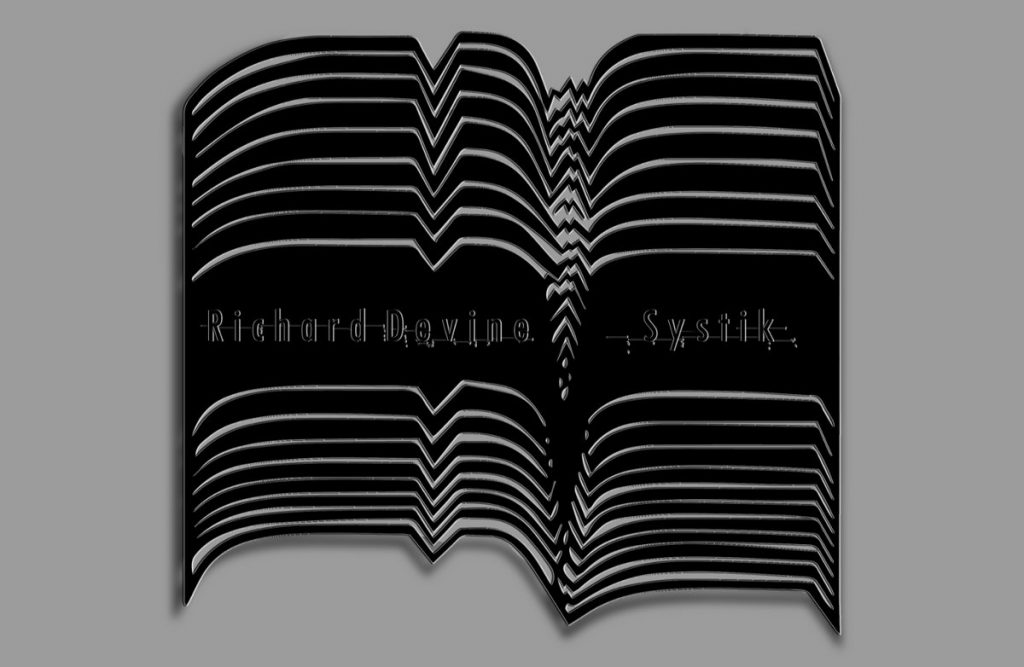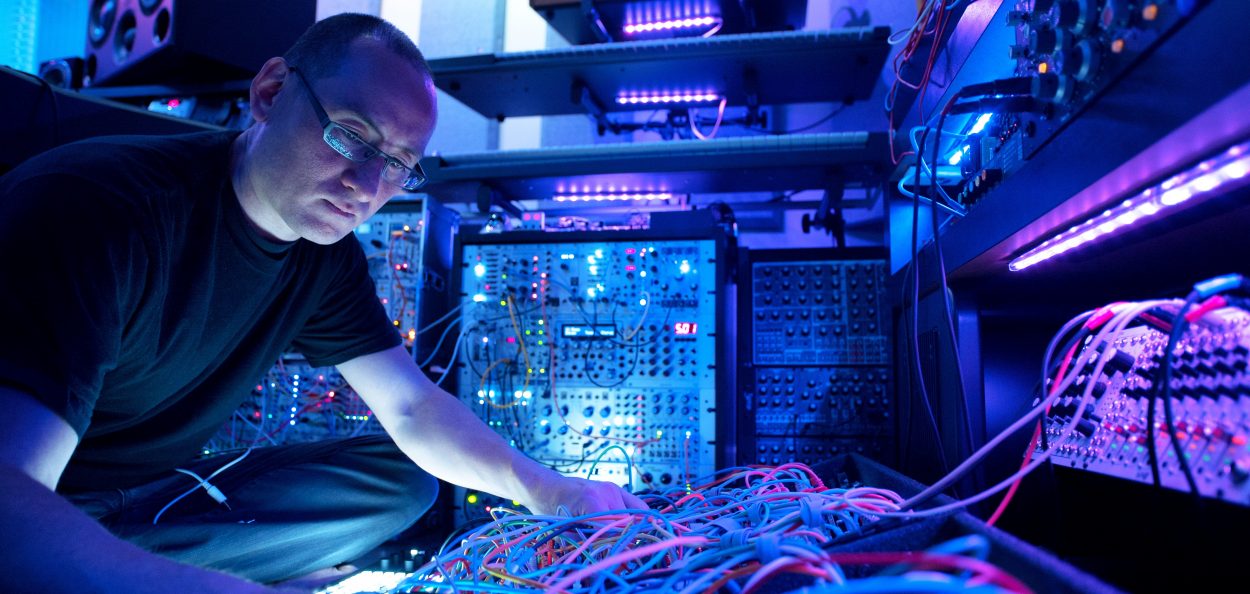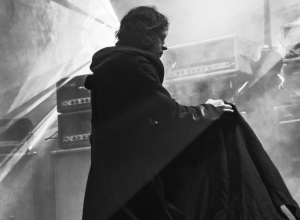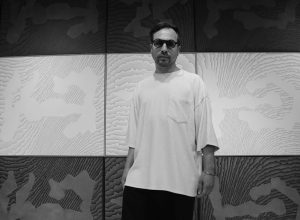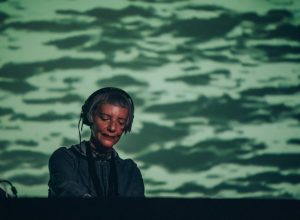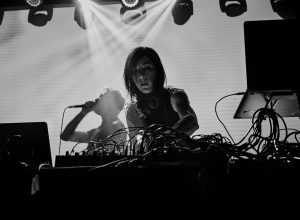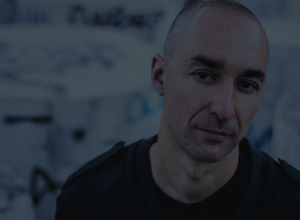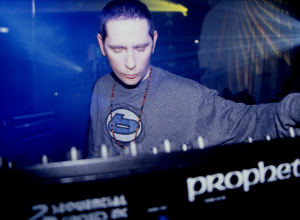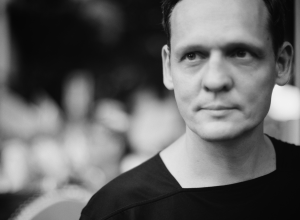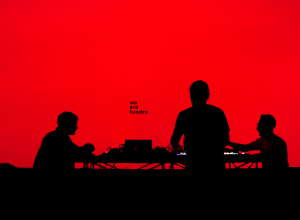For most of those paying attention to the world of electronic music creation, Richard Devine is a familiar name. His social media feeds are an unceasing stream of experiments constructed out of new music production tools, ranging from standalone and modular synthesizers to VST plugins and mobile software. For years now, it’s felt like every music toolmaker and gear manufacturer on the planet has been compelled to get their creation in front of Richard Devine—upon release and often well before, when he’s typically asked to create presets or patches for products in development.
Over the past twenty-plus years, Devine’s glitchy, often swarming music has been released on labels like Detroit Underground and Schematic, and his expertise as a sound designer has been tapped by the likes of companies such as Sony, Jaguar and Nike. He’s created patches and presets for hardware and software releases from music instrument and technology companies including Korg, Moog, iZotope, and Native Instruments.
Richard Devine’s compositions are often dense, angular affairs, infused with a level of hyperkinetic movement and dynamic, intricate layering that aptly reflects Devine’s own technological prowess. The process behind his work has travelled over the years from classic hardware synths and drum machines to “in-the-box” computer-based synthesis and recording techniques, and perhaps most famously to the extensive, sprawling modular synthesizer collection he’s amassed over the course of the past decade.
We spoke to the Atlanta-based musician about his favorite synthesizers and sound design projects, his creative process, and one particularly memorable live performance in Italy that, appropriately enough, took place during an unprecedented electrical storm.
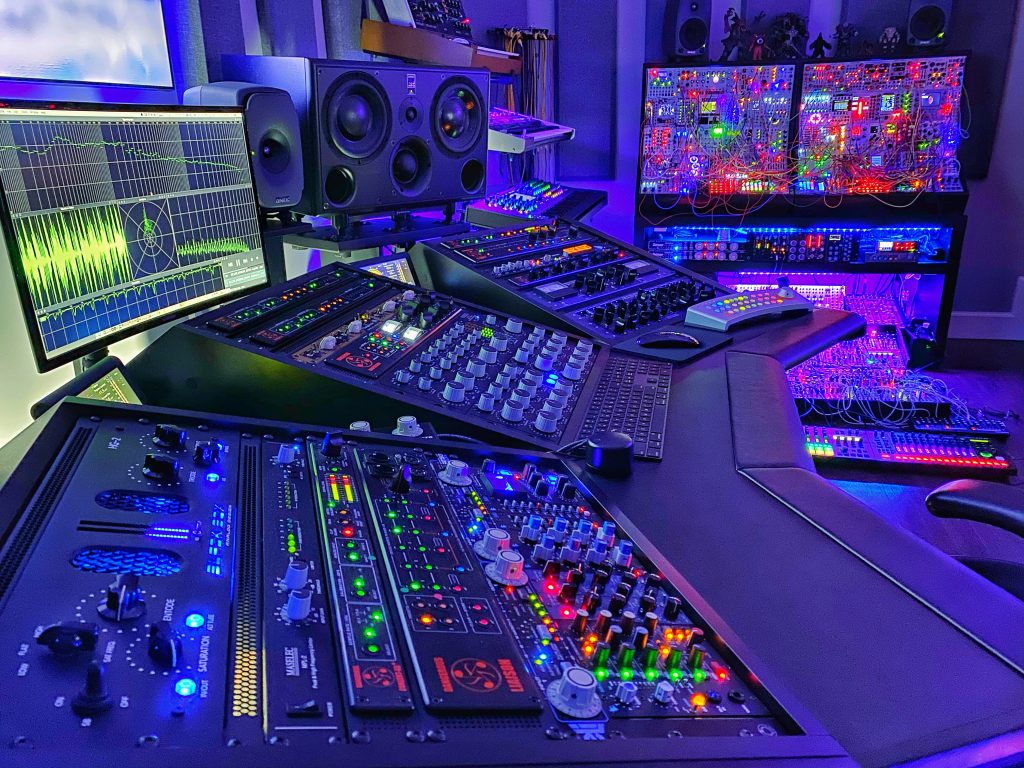
Of all the music gear releases you’ve been involved with, which one did you feel most deeply attached to?
I’d say it would have to be the Waldorf Quantum synthesizer that I worked on with Rolf Whormann. To me, it’s hands down one of the most interesting and inspiring synthesizers to come out this decade. I also worked with Rolf on his iOS/VST instrument plugin called “Nave,” which borrowed a lot of the same technology. So I was somewhat familiar with the wavetable synthesis engine, but with the Quantum and Iridium, he pushed things even further. This is the first synth that I felt was designed for sound designers looking to push synthesis in new directions. It combines granular/particle, physical modeling, FM, subtractive, and wavetable all in one intuitive, beautifully ergonomic keyboard. It’s a joy to make sounds on, and the sound quality is excellent.
The other synth would be the Clavia Nord G2 modular, for which I created around 128 factory patches back in 2004. It remains one of my favorite digital synthesizers, and I still use it even today.
You were an early adopter of the Eurorack modular format. Do you still feel the same sort of enthusiasm towards the format? Has this golden era of hardware made it difficult to force yourself to sit down at the computer and noodle around with a mouse and keyboard?
I still use Eurorack modulars almost every day here, for a lot of my own music and sound design work. I’m still discovering new combinations and new modules almost every week. There are literally thousands of new modules coming out now, and I feel there are so many interesting things happening in the Eurorack world. I created my last three records entirely out of the box using modular and various hardware.
I sort of went full circle, as I used to create and compose music with hardware back in the early ’90s. It wasn’t until 1996/97, when I started using computers for synthesis, sound design, and composition. I love the physical interactive feedback you get with working with hardware. This is not to say that I think making music on computers is a bad thing—I still think that the computer is the most advanced musical instrument in the world. You can do almost anything on the computer. I’ve personally gone back to using hardware just because I’m trying to break my old habits with using computers. With the computer, I can always go back to projects and save songs use presets, which isn’t a luxury with modular. Where you have to record the patch before it’s gone. There’s this element of risk and danger with using the modular, in that at any second you could lose it all. So the record button is always on.
In addition to creating patches and sound design for new hardware and software products, you’ve also done quite a bit of client work, like designing the UI and engine sounds of Jaguar on their first all-electric vehicle, and working on Stadia as well as augmented reality tools for Google. What have been some of the most interesting projects you’ve worked on recently?
There have been so many fun projects, but I would say most recently doing sound design and music for the new Cyberpunk 2077 game soundtrack. That was an incredibly fun project, as they gave me complete freedom to push the sound design and music as crazy as possible. Before that, I’d say working with Mick Gordon on the Doom soundtrack was also really fun. I love how much games have evolved, and how much more immersive the audio has become. They’re really trying to make the sonic experience as intense as possible.
Another fun project was creating all the user interaction sounds and ambisonic ambiances for the Google Earth VR app. Flying in VR to any location on the planet is really fun, and creating the 360 sound environments for all of the various locations was really challenging but fun.
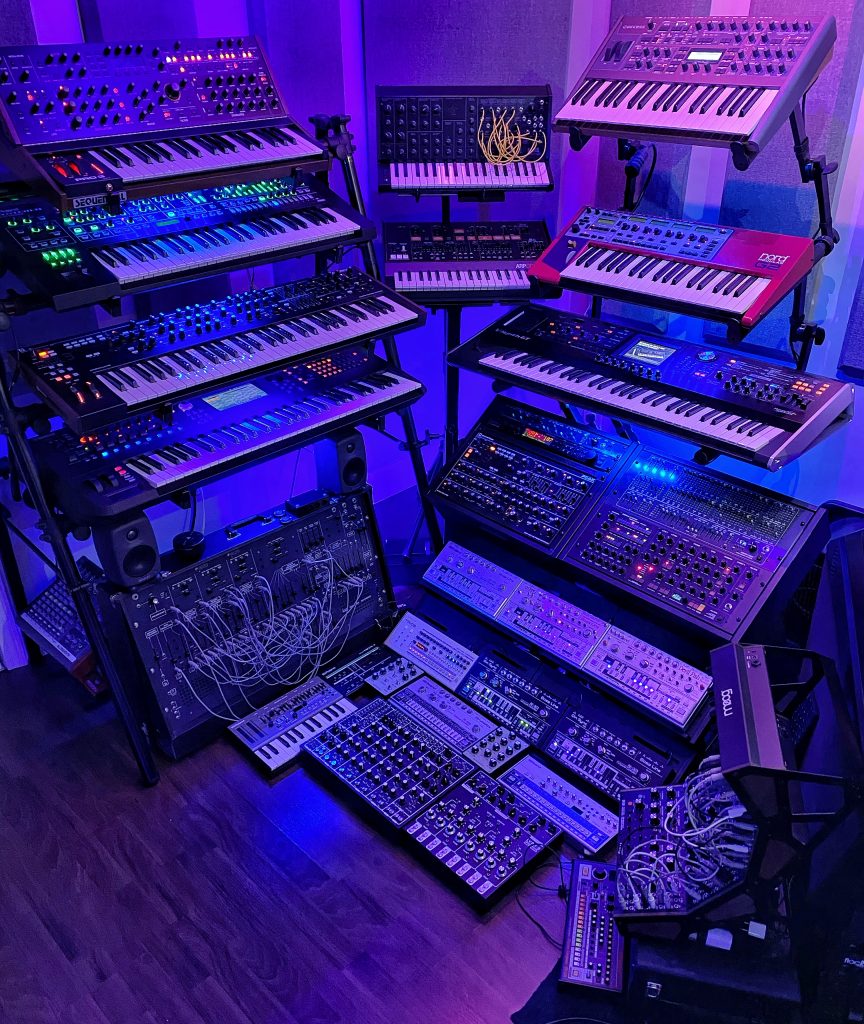
What excites you the most about the future of music technology?
I’d say the use of machine learning and AI-based technology, as it can be applied to music composition creation and for sound design applications. I’ve been researching the newer generative instruments, which can help users create chords, melodies, and rhythms. I find a lot of these newer instruments really interesting, trying to abuse and use them in ways they may have not been intended to be used. I’ve also been recently experimenting with live coding, using Tidal Cycles and supercollider. I’ve been having a blast interfacing Tidal Cycles as my main sequencer into the modular. It’s opened up a new wormhole of possibilities.
How do you manage to not get overwhelmed with the amount of gear that enters your studio? Do you have a general organizational approach that you try to stick to?
I often take the approach of learning one piece of gear at a time, and spend some serious time learning what that one piece can do. I often like to see how many different sounds I can get with just one instrument, so I like to try and create an entire piece of music with that instrument. You’ll quickly see the strengths and weaknesses of that instrument, just by seeing what it can do. I work much better with smaller more intimate setups, so I try to impose limitations on myself. I feel that I can digest the information better in smaller chunks. Just because you have a lot of gear doesn’t mean you should use all of it at the same time. I feel choosing a few key pieces can get you really far.
What are some of the other tools that you’ve found most inspiring over the last year or so?
I would say the Soma Labs Pulsar-23 organismic drum machine designed by Vlad Kreimer, Erica Synths’ Syntrx, and as I mentioned the Waldorf Quantum, which is easily my favorite synthesizer to come out in the last 10 years. I recently got the Moog One 16-voice. It’s an immensely vast, deep machine, with lots of incredible features.
Over a longer period of time, what are some of the tools you keep most accessible, and find yourself coming back to the most?
I would say the one piece I keep going back to is the Nord G2 modular. I’ve used two of them since 2004. I’ve created hundreds of patches over the years, which I’ve been using in my sound design projects and music tracks. It was so ahead of its time—it’s the perfect hybrid system, in which you patch with the G2 modular software, and then assign the controls to the synthesizer knobs and buttons.
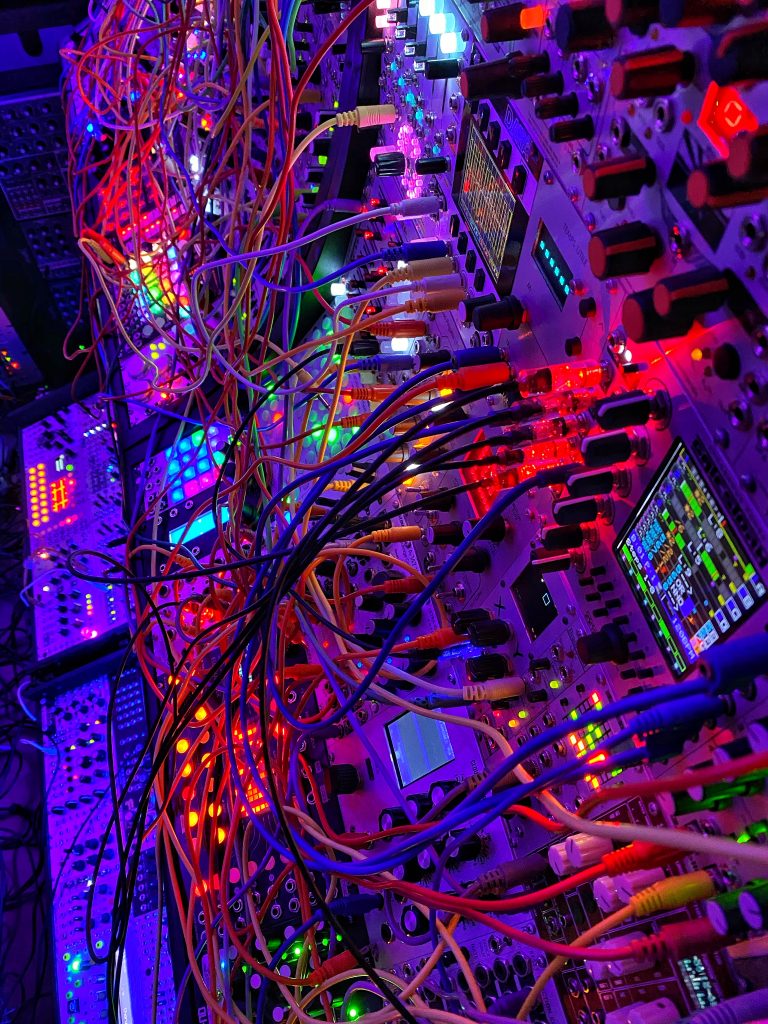
You recently shared some great anecdotes about a Warp Records show you played some time ago. Can you share any other memorable experiences you’ve had playing live?
I’ll never forget this festival I played at in Rome called “Bitz.” I think it was around 2002 or 2003, I was playing at one of the main stages in this huge concrete building with Plaid and Venetian Snares. I remember it was completely packed with close to a thousand people. It was raining and it was also White Night, so everyone was out partying throughout the city.
There were so many people in the venue that I got pushed up against the wall, and my laptop screen was crushed. I had to play my set with a completely smashed screen, and I remember Aaron Funk standing on stage behind me telling me to keep playing, cheering me on. I was only halfway through my set playing this track called “Rusex Fee,” which has these distorted crazy builds. I remember playing that track and the crowd was screaming, and then all of a sudden the power goes out, and all of the lights in the venue suddenly go dark. The crowd screams again and thinks it’s part of the show, but I quickly realize that something was wrong. Two of the stage engineers jump on stage and start yelling at me, “You blew the entire system.”
Confused, I began checking my setup, and realized the only thing left on was my laptop, which had this tar-black motor oil liquid dripping out of the cracked screen. The power never came back on, so we all went up to the VIP room where I watched the band “Mum” play around a small fire on the roof, in the rain, with a couple of violins and acoustic instruments.
Then I remember the promoter trying to figure out how he was going to get us back to our hotel. There were thousands of people stranded, as all the public transit had shut down—it was the first time in history that the city of Rome had no power. We finally got a taxi back to our hotel, and I remember using my laptop as a flashlight as I walked up the emergency stairs to get to my room. I only had a few hours to grab my stuff and head to the airport. When I arrived I saw many people reading the newspapers, and they’re saying that a bunch of trees had fallen onto four of the major power lines that supply electricity to the city of Rome. Everyone still remembers that night where I blew out the entire city of Rome from one track!
When you’re not working, how do you listen to music, generally? What kind of stuff do you find yourself gravitating toward? Any new records or artists over the past few years that have really blown you away?
I generally listen to music on vinyl, and of course digitally, where I prefer to listen to music in either FLAC or WAV. Lately, I’ve been listening to a lot of electroacoustic music—artists like Jonty Harrison, and Laurent Delfouge. I’ve been loving the work of Grischa Lichtenberger on Raster Music, and I’ve also been loving the stuff coming out on Conditional Records, and the work of William Fields. William Fields’ OS album is amazing, and shows how far algorithmic music has come.
Finally, what’s something about you that people might not glean from, say, your Instagram/Twitter profiles? Maybe any low-key passions or hobbies in your life?
I think most people think I mostly live inside my studio, but the reality is that I like going outside a lot for hikes in the mountains, near waterfalls, and kayaking on rivers and lakes. I spend a lot of weekends with my family outdoors, visiting different state parks and just getting out into nature. It’s a nice way to reset the brain after a long week in the studio.
Richard Devine’s latest release, Systik, is available now on BL_K NOISE via Bandcamp.
